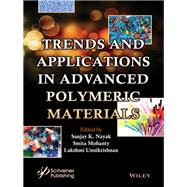This comprehensive compilation of contemporary research initiatives in polymer science & technology details the advancement in the fields of coatings, sensors, energy harvesting and gas transport.
Polymers are the most versatile material and used in all industrial sectors because of their light weight, ease of processing and manufacturing, the ability to mold into intricate shapes, and its cost-effectiveness. They can easily be filled with a range of reinforcing agents like fibers, particulates, flakes and spheres in micro/nano sizes and compete with conventional materials in terms of performance, properties and durability. Polymers continue to be discovered and the demand for them is increasing.
The book comprises a series of chapters outlining recent developments in various high performance applications of Advanced Polymeric Materials. The topics covered encompass specialized applications of polymeric matrices, their blends, composites and nanocomposites pertaining to smart & high performance coatings, high barrier packaging, solar energy harvesting, power generation using polymers, polymer sensors, conducting polymers, gas transport membranes and smart drug delivery systems.
Thus, the theme of the book embraces all the latest innovations and future applications of polymers and related materials. What is novel about this book is that it delineates the applications from a research point of view through descriptions highlighting specific developmental criteria.








